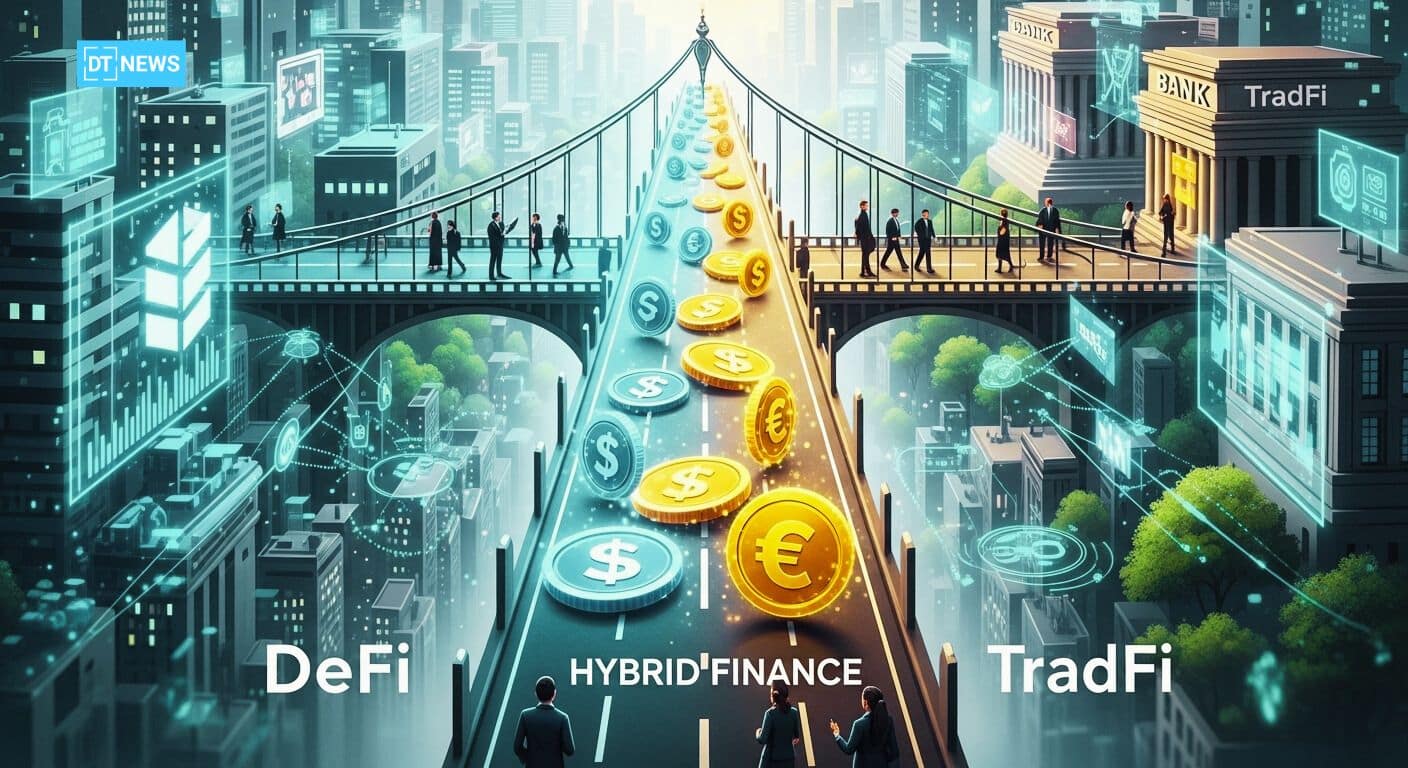This article was first published on Deythere.
- How Stablecoins Bridge TradFi and DeFi
- Crypto Payment Networks and Hybrid Solutions
- Where DeFi and TradFi Integration Is Happening
- Expert Voices: Perspectives on DeFi and TradFi Integration
- Global Impact: Financial Inclusion and Growth
- Barriers and the Path Forward
- Conclusion
- Frequently Asked Questions About DeFi and TradFi Integration
DeFi and TradFi are converging in 2025 with new regulations, stablecoins and payment innovations. Big banks and institutions like BlackRock, Fidelity, and JPMorgan have launched crypto-related services, suggesting that DeFi and TradFi integration is going mainstream.
Landmark policies like the U.S. GENIUS Act now allow banks to hold stablecoins, building a bridge between the TradFi and DeFi worlds. Meanwhile; global payment networks are rolling out hybrid on-ramps.
A good example is Mastercard’s 2025 partnership with Chainlink which allows users to buy crypto directly on decentralized exchanges using any Mastercard. This opens the era of hybrid finance where crypto efficiency and familiar payment rails come together.
How Stablecoins Bridge TradFi and DeFi
Stablecoins act as the bridge in DeFi and TradFi integration. With over $250 billion in circulation and about $30 trillion transferred in 2024, stablecoins now prop up global payments. They allow instant, low-cost transfers that bypass legacy networks.
Stripe and Visa now accept stablecoin payments, instantly converting them to fiat. This means a merchant can receive USD-equivalent value in seconds, instead of days via SWIFT.
In effect; stablecoins allow businesses to bypass entrenched gatekeepers, such as card networks and correspondent banks, creating near-instant ledger-to-ledger settlements.
New regulations have accelerated this trend. The GENIUS Act provides legal certainty so banks can hold and settle in stablecoins, giving TradFi the confidence to adopt blockchain. Big banks like JPMorgan, Citi, Goldman, etc. are now actively exploring stablecoin products.
Crypto Payment Networks and Hybrid Solutions
Hybrid payments are the simplest practical idea for bringing crypto into everyday life; lets people use digital assets but pay and settle over the familiar rails they already trust.
In the present financial setting, hybrid payments are emerging as crucial to combining both the fields of decentralized finance (DeFi) and traditional finance (TradFi).
Payment networks and fintechs are building the plumbing for crypto usage. Hybrid payment solutions allow crypto assets to interact with familiar services like Visa or Mastercard. Mastercard’s June press release announced that any of its 3.5 billion cardholders can now buy crypto on Uniswap through its new Swapper Finance app.
This on-chain conversion is regulated, uses stablecoin intermediaries and connects directly to Mastercard’s payment rails.
As Mastercard’s Raj Dhamodharan says
“This is what crypto looks like when it’s ready for the real world… bringing our proven expertise and global payments network together… enabling billions of people to participate in the crypto economy with the cards in their wallets today”.
Visa has been testing stablecoin payments for cross-border transfers and pilot programs saw crypto-linked card usage in the billions.
One analyst noted that crypto card transactions exceeded $3 billion in a single half-year pilot. These numbers show consumer demand for hybrid payment options.
Fintechs like YoguPay say Payment Service Providers (PSPs) can leverage existing merchant networks and trust to bridge TradFi and DeFi.
In a real world use case, crypto wallets and on-ramps are now integrated into banking apps and cards. A user can preload a debit card with USDC or Bitcoin and spend it anywhere Visa/Mastercard are accepted.
The crypto settles in the background via blockchain, but the user experience is indistinguishable from a normal card swipe.
Benefits of this DeFi TradFi Hybrid Crypto Payments include instant settlement, lower fees, global reach, and financial inclusion.
Where DeFi and TradFi Integration Is Happening
| Segment | Example | Benefit |
|---|---|---|
| Payment cards linked to crypto | Crypto wallet + debit card networks | Consumer-friendly access to digital assets |
| Tokenized real-world assets (RWAs) | Bonds, Treasuries on blockchain | Brings TradFi assets into DeFi liquidity pools |
| Institutional on-ramps | TradFi securities; asset managers using DeFi rails | Large-scale capital flows into DeFi ecosystem |
Expert Voices: Perspectives on DeFi and TradFi Integration
Industry experts agree that DeFi-TradFi integration trend is accelerating. Alvin Kan says “the dominant trend in DeFi is its growing integration with TradFi” as institutions seek yields and transparency.
Kean Gilbert (Lido) notes institutional adoption is needed for DeFi growth; but it must be balanced against risks of centralization.
Jeremy Allaire (Circle CEO) predicts stablecoins could be up to 10% of world money by 2034; effectively bridging the two systems.
These voices; along with moves by Visa, PayPal and banks, suggest a growth flywheel is forming: TradFi infrastructure lends trust and liquidity; while DeFi innovation brings new products and efficiency.
In October, global crypto ETFs were approved and crypto saw massive inflows and euphoria. BNY Mellon and other custodians now offer crypto custody services, anchoring digital assets in bank vaults.
Regulatory progress helps too. The GENIUS Act and global statements (EU, UK, Singapore) on stablecoins give banks a way to participate. Institutional investors can treat tokenized assets as normal.
In short; experts see DeFi and TradFi integration as an evolutionary step: combining the best of both worlds for more financial innovation.
Global Impact: Financial Inclusion and Growth
One of the biggest benefits of DeFi and TradFi integration is financial inclusion. Globally; reports claim about 1.7 billion people are unbanked with no access to formal banking.
Blockchain and crypto offer alternative rails: a smartphone user in a developing country can hold a stablecoin or crypto wallet and transact globally without a local bank.
As experts say, stablecoin wallets could be a path for the unbanked to create a stable store of value and exchange. Payment cards linked to crypto like Binance, Wirex etc.; already enable remittances and payments in emerging markets, reaching people left behind by traditional banks.
Additionally, TradFi and DeFi integration can reduce costs and growth. PSPs using crypto rails cut cross-border fees by up to 70%, savings that can be passed to consumers. Faster settlement (seconds vs. days) means better cash flow for businesses.
Regions with volatile currencies (Latin America, Africa) are already using stablecoins for remittances, and mainstream support will only accelerate this.
Barriers and the Path Forward
Despite the progress, there are still hurdles to full integration. Past distrust is a big one. DeFi pioneers often resist legacy systems because of past TradFi failures, while banks worry about crypto volatility and compliance. To overcome these DeFi and TradFi barriers requires compromise.
As the IMF says, “both sides need each other. If crypto is to go mainstream, DeFi and crypto must adopt some of the regulatory practices that have brought stability to TradFi”.
Obstacles include regulatory ambiguity, technical complexity and isolated “data silos”. To remove them:
Clear Rules must be set. Uniform regulations on crypto assets like the stablecoin frameworks will give TradFi the confidence to participate.
Blockchain standards and open banking APIs must connect systems seamlessly.
Wallet and smart-contract interfaces must be simple. Just as HTTP made the web user-friendly, smoother DeFi user experiences will increase adoption.
Importantly, integration is not a zero-sum game. Tech leader Michael Casey says DeFi and TradFi can thrive together to solve big problems like climate funding. By discarding old divisions, incumbents and startups can co-create better services.
Conclusion
DeFi and TradFi integration entails combining crypto’s innovation with traditional finance infrastructure. Recent milestones from stablecoin laws to on-chain crypto payments with Visa/Mastercard; show the two can work together.
By combining DeFi’s efficiency with TradFi’s scale; the hybrid ecosystem is becoming a reality. This means faster, cheaper payments and broader access to financial services for everyone from retail users to global corporations.
Stakeholders should focus on building user-friendly bridges; secure wallets, compliant APIs; and harmonizing standards to make this integration work.
Glossary:
DeFi (Decentralized Finance): This term includes all kinds of financial systems like lending, trading, and payments that are based on blockchain and work without the need for a central authority.
TradFi (Traditional Finance): This term refers to all the existing financial services and products taking place through the traditional banking system, which involves banks, stock exchanges, and payment networks, etc.
Stablecoin: Its main feature is that it is a digital currency whose value is tied to that of a fixed asset (like the US dollar or gold) in order to lower the price swings; thus it can be used for payments and fiat-crypto bridging.
Payment Service Provider (PSP): These are companies that are responsible for processing electronic payments between consumers and merchants (like Visa, PayPal; fintechs).
On-ramp: It means a service that allows the transformation of traditional money (like US dollars) into cryptocurrency; this is the first step to access the digital currency market.
Frequently Asked Questions About DeFi and TradFi Integration
What is DeFi and TradFi integration?
Blending decentralized finance (blockchain-based) with traditional finance (banks, payment systems); so they work together.
Why is this important?
So the mainstream financial system can use crypto innovations while having security and regulation; and accelerate adoption.
How do stablecoins help bridge the gap?
Stablecoins are crypto tokens pegged to fiat currencies. They enable instant; low-cost transfers directly on blockchain while preserving familiar values (like USD), making fiat-crypto conversions easier.
What role do payment networks play?
Networks like Visa and Mastercard are partnering with blockchain projects to allow crypto purchases and payments via existing cards; making crypto spending as easy as normal card use.
What are the challenges?
Regulatory uncertainty; technological complexity, trust issues. Overcoming them requires clear rules; user-friendly tools and collaboration between fintech and financial incumbents.



















































































































